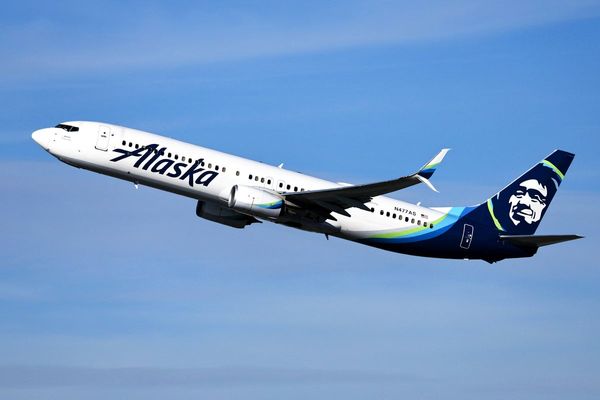An operation to tow a cargo ship stranded off the Royal national park, south of Sydney, to safety before further bad weather sweeps in has been “progressing well”, with efforts expected to continue well into Monday night.
The New South Wales Port Authority said while “not out of the woods” yet, the operation to save the Portland Bay was “heading in the right direction”. As of 6pm on Monday, the vessel was 2.5 nautical miles from shore amid volatile conditions.
Three tugs were moving the ship to safer waters, while the “critical step” of raising the anchors of the ship was realised. The tugs were travelling at 1.5 knots, placing the ship on track to be a safer 12 nautical miles off the coast by midnight.
#WATCH // The @Lifesaverhelo remains on alert to respond to a stranded ship off the Illawarra coast.
— Surf Life Saving NSW (@slsnsw) July 4, 2022
It's a tricky situation, with tower cranes on the ship interfering with any winching attempts. pic.twitter.com/Qp9hbG22PM
“Our priorities remain twofold – getting this vessel and its crew into safer waters and away from land and the potential of grounding, while keeping all responders safe,” said John Finch, chief operating officer of the port authority.
Finch said response crews would continue the operation “for several hours” despite “atrocious” ocean conditions.
“Our thoughts are with them and the crew as they continue the slow and delicate operation to remove this vessel to deep water,” he said.
“The crew are all safe and in good spirits at this stage.”
The alarm was raised earlier on Monday when the Portland Bay suffered a power failure and began drifting towards the Sydney coast.
Early attempts by emergency services to rescue the stranded bulk carrier were hindered by wild seas and torrid conditions. An aerial mission to winch the 21 crew members to safety – involving police, emergency rescue and defence helicopters – was called off due to turbulent weather.
Finch said preliminary advice from the ship’s crew was that the vessel’s turbo engine blower had failed which would be a “relatively straightforward repair” taking four to six hours.
“Cars fail, ships fail, that’s what happens sometimes at sea. Unfortunately, we just happen to be in atrocious conditions at the moment, we’ve got eight-metre swells, 30-knot winds, it’s atrocious … to be operating in,” he said.
“It’s going to make the towage operation quite difficult because you can imagine in an eight-metre swell the vessel is going to be rising and falling, rolling.”
The ship carries about 1,000 tonnes of heavy fuel oil and could cause an environmental disaster if it runs aground, experts say.
By mid-afternoon, three tugboats were deployed in close proximity to the ship in an attempt to stabilise the 170-metre long vessel and stop it from drifting further from its precarious position 1.8km from the shore.
“We’ve got … two anchors deployed … and then we’ll mobilise those tugs to secure some heavy towage lines, and then we’ll start the process of retrieving the anchors and getting the vessel towed out to deep safe water,” Finch told reporters.
“That’s probably going to take two to three hours because the vessel … deployed both her anchors and put out quite a considerable amount of cable so we’ve got to retrieve that cable … very slowly.
“Safety is paramount here, protecting the tug crews that are working to get a safe outcome.”
Finch said the master of the vessel intended to keep the crew onboard the ship after an initial plan to rescue the passengers stalled.
“Once the vessel deployed its anchors and it was in a stable condition … the master asked to keep his crew on board because at this point in time they’re confident they can make an engine repair once they get into safe, deep water,” he said.
#WATCH // @Lifesaverhelo is responding to a stranded container ship off the Royal National Park. Conditions are currently too rough to attempt to winch the crew from the ship.
— Surf Life Saving NSW (@slsnsw) July 4, 2022
The ship has no power and is currently 1nm offshore. IRBS from #thirroulslsc and a jetski are on standby pic.twitter.com/O5s5TViek5
“They’re confident they’ve determined exactly what the issue is with the main engine, they have spare parts on board, they do have qualified marine engineers on board who can effect those repairs.”
The ship departed Port Kembla in Wollongong at about 1.30pm on Sunday and lost power off the coast on Monday, drifting back towards the east coast.
Bulk carrier Portland Bay looks out of control very close to running aground near Sydney’s Royal National Park. pic.twitter.com/LKB9Zaho78
— Ronaldo (@RoryRonaldo) July 3, 2022
Dr Reza Emad, a marine safety expert with University of Tasmania’s Australian Maritime College, said the vessel – a so-called “handysize” bulk carrier, owned by the large, Hong Kong-based maritime logistics company Pacific Basin – would probably have about 1,000 tonnes of fuel on board.
“If a ship goes aground for any reason, even if they are not tankers, the amount of fuel that they carry … this one carries about 1,000 tonnes of heavy fuel oil, which is really dirty,” he said.
A similar cargo ship caused an environmental disaster after running aground in Sri Lanka, he said.
“The amount of fuel that it had – it was about 1,000 tonnes – it polluted the coast. They said it was the worst sea pollution that they’d had ever in their history.
“The danger is always there, but we are talking about Australia, we are talking about NSW, we are talking about one of the most sophisticated maritime operations in this country.”
Emad said the vessel was designed to operate in dangerous water and conditions, despite being smaller than most other cargo vessels.
But he said ships like the Portland Bay were under immense pressure to make constant journeys due to the costs involved in their operation.
“There’s no rest,” he said. “From the graph I can see that it’s empty [of cargo]; normally it is loaded. But it seems that it came, discharged, and now it is going to a second port without a minute of delay, because each ship costs, daily, up to $100,000 … So it cannot be left idle.”







